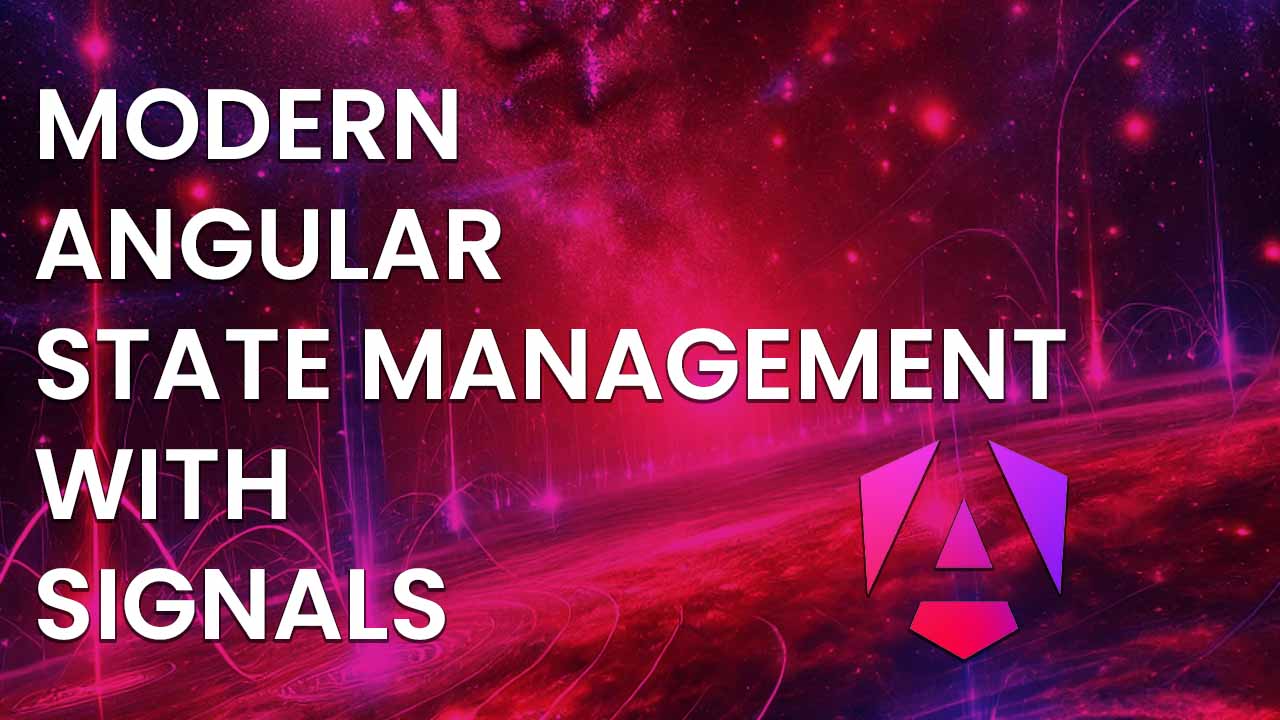Modern Angular State management with signals

State management is a topic that I love, and it is one of the most discussed topics in companies. There are various ways of managing state, this article will go over the history of state management, and how I handled state in the past and now. This article is about modern state management practices that can be applied without any third-party lib.
History
State management in Angular has evolved a lot over the years. In the following steps I will explain how state management evolved for me and which best practices I use today.
Models
We started out with putting state in models. Models are typescript classes that contained properties of state. The properties in those models where values and objects that were mutated.
The lack of immutability and unidirectional dataflow resulted in unexpected behavior and made it hard to track bugs and develop in a consistent way.
The redux pattern
After models, we started using the redux pattern, mostly with @ngrx/store, which led to a more consistent way of handling state and forced an immutable unidirectional dataflow. To enforce consistency, we started putting all state and data in the store.
The downside of this is the following:
- Crazy amount of work/code.
- Actions don’t return a value so we have to put everything in the store if we want to read it.
- A lot of boilerplate code.
- Effects calling effects can be overly complex.
- Maintaining and writing tests became time intensive.
BehaviorSubject services
As the pain of the redux pattern became to big for me personally, I evolved towards simple services that contained BehaviorSubjects. The nice thing is that we could leverage the Angular dependency injection system to determine the lifecycle of a piece of state:
- Providing the service on component level, would share the lifecycle of that component, and would destroy the state together with that component.
- We could have state per component, per lib, and as a global singleton.
Using BehaviorSubject services made it possible to ditch state management frameworks and keep it simple. A shopping cart state machine would look like this:
@Injectable()
export class ShoppingCartStateMachine {
// A BehaviorSubject behind the scenes
readonly #entries$$ = new BehaviorSubject<ShoppingCartEntry[]>([]);
// Exposed as an observable
public readonly entries$ = this.#entries$$.asObservable();
// A snapshot for easy access
public get snapshot(): { items: ShoppingCartEntry[] } {...}
// Some manipulation methods to update the state
public addToCart(entry: ShoppingCartEntry) {...}
public deleteFromCart(id: number): void {...}
public updateAmount(id: number, amount: number): void {...}
}
This was simple, clean, but also had problems:
- It wasn’t that opinionated.
- It needed a lot of know-how of RxJS.
- To calculate state based on state we needed complex
combineLatestoperators. - Updating multiple pieces of state at the same time resulted in multiple emissions in the
combineLatestoperators. - We needed to subscribe/unsubscribe on state.
Frameworks evolved and I created ObservableState
Frameworks got simpler and we started removing things from the store and keep them on component level. We had @ngrx/component-store and rx-angular playing a big role in that. They made state management on components possible.
However, I wanted to keep my dependencies to a minimum, so I created ObservableState. A lightweight 100 line class that solved the following issues for us:
- It automatically unsubscribed from observables
- It provided a snapshot
- We could update multiple pieces of state at the same time without triggering the state multiple times
- We didn’t need
combineLatestanymore - It distinct the changes automatically
- We didn’t have issues with multicasting anymore
I used ObservableState in big applications in production and it made my life easier. I also started using the ViewModel pattern where I created a reactive observable specifically for the template. The viewModel of a pager component could look like this:
protected readonly vm$ = this.state$.pipe(
map(({itemsPerPage, total, pageIndex}) => {
return {
...
nextDisabled: pageIndex >= Math.ceil(total / itemsPerPage) - 1,
itemFrom: pageIndex * itemsPerPage + 1,
itemTo: pageIndex < Math.ceil(total / itemsPerPage) - 1
? pageIndex * itemsPerPage + itemsPerPage
: total,
}
}
))
The advantages of viewModels:
- Only one subscription (async pipe) needed.
- No more template logic, everything is in the class, and the template became extremely readable and clean.
- No more multicasting issues (multiple subscriptions triggering multiple rest calls).
Signals
Moments before I gave my talk at NG-BE 2023 about Reactive patterns in Angular enterprise solutions, the Angular team dropped a bomb. Signals, a new reactive primitive to simplify state management. Did my talk just became obsolete?
The cool thing is, signals solved the exact same things I was solving with ObservableState:
- No more RxJS complexity
- No more subscribing/unsubscribing
- Easy snapshots, no more
withLatestFromstuff… - Memoization
- …
I loved signals from the start, they were so simple and elegant. I decided to create ngx-signal-state which again
was used in big projects for big clients (even though the npm package never really took off). ngx-signal-state had the same api
as ObservableState, resulting in easy refactors towards signals.
State management in 2024
When doing software development, we don’t have the luxury of putting or heads in the sand. We constantly have to zoom out and look at the problems differently. We have to re-evaluate all the time. Frameworks evolve, so we have to adapt as well.
I sell an Angular Boilerplate that focuses on scalable architecture,
supabase-integration and showcases a real app called influencer. The whole goal of this boilerplate is to let you start building
immediately. I have done all the hard work, so you can just start building your app and be productive from the beginning.
Anyway, this Boilerplate had one issue. It had a dependency on ngx-signal-state, because… Well, I loved managing state
with that library. However, people that want to buy my boilerplate might not want to learn ngx-signal-state.
Having a dependency like that in a boilerplate that you sell, is not an advantage.
Dropping ngx-signal-state
Just for fun, I started refactoring pages towards signals instead of using signal state. It turned out that:
- I removed a lot of boilerplate code
- Templates change detection is optimized for signals
- I was working closer to Angular
- I could remove a dependency, which is always a nice thing to do if it makes sense
I refactored my entire codebase, (the private version of that repository contains a bunch of applications) and it was a great success. My code got cleaned up a lot, performance was improved and I could work with “just Angular”
Dropping ViewModels
ViewModels also don’t make sense anymore when it comes to using signals. When using signals I calculated my ViewModels like this:
export class UserComponent {
readonly #firstName = signal('Brecht');
readonly #lastName = signal('Billiet');
private readonly viewModel = computed(() => {
return {
fullName: `${this.#firstName()} ${this.#lastName()}`
}
})
protected get vm () {
return this.viewModel();
}
}
In the template I could now read the vm like this:
{{vm.fullName}}
Why was I still doing this? What was I trying to solve?
- I didn’t want template logic.
- I didn’t want multiple subscriptions on my Observables.
- I didn’t want multicasting issues.
- I didn’t want to deal with
combineLateststuff or other RxJS complexity.
All those arguments were invalidated by signals. I could just use computed signals and optimise performance and remove boilerplate code:
export class UserComponent {
readonly #firstName = signal('Brecht');
readonly #lastName = signal('Billiet');
protected readonly fullName = computed(() => `${this.#firstName()} ${this.#lastName()}`);
}
The template would now look like this:
{{fullName()}}
While I didn’t like the () syntax in the template, there was another important reason why I decided to drop viewModels.
Angular is working on more optimized change detection in templates, and having one big computed signal would just be bad
for performance.
In other words: Ditching ViewModels is good for performance
Some best practices when it comes to state-management
Keep the state as low as possible
If you can keep it in your component, keep it there. Do you need to share it with a sibling, keep it in your parent component. If you only need it in your feature, keep it in your feature. Only if you really need it on a global level, make it a singleton. Providing the state as low as possible will result in simpler state management and less complexity.
Don’t expose writable signals
Keep your writable signals private to ensure unidirectional dataflow.
You can expose setters or methods to update a piece of state. To expose a signal without its write functionalities
we can use the asReadonly() method.
@Injectable()
export class ShoppingCartStateMachine {
readonly #entries = signal<ShoppingCartEntry[]>([]);
// Don't expose the writiable signal
public readonly entries = this.#entries.asReadonly()
// State update methods
public addToCart(entry: ShoppingCartEntry) {...}
public deleteFromCart(id: number): void {...}
public updateAmount(id: number, amount: number): void {...}
}
Use signals for state management, RxJS for event management
While we can ditch 90% of the RxJS functionality and simplify it with signals. RxJS for state management is hard, because we have:
- Multicasting issues
- Glitches
- Error handling
- Memory leaks
- A good knowledge of RxJS
For state management we should use signals. For event management we should use RxJS. Angular has created RxJS interoperability for that:
toSignal(obs$)creates a signal from an observabletoObservable(signal)creates an observable from a signal
When do we need it, when managing events, for instance while fetching data. In the following example we want to load users based on a query, sorting and pageIndex. It should be clear what is state management and what is event management:
export class UsersListSmartComponent {
...
// State, extracting from the activated route
readonly #query = toSignal(
this.activatedRoute.params.pipe(map(v => v['query'])),
{ initialValue: this.activatedRoute.snapshot.params['query'] }
);
// Simple state
readonly #sorting = signal({direction: 'ascending', sortBy: 'name'});
// Simple state
readonly #pageIndex = signal(0);
// Simple state
readonly #input = computed(() => ({
query: this.#query(),
sorting: this.#sorting,
pageIndex: this.#pageIndex
}));
// Event management
protected readonly results = toSignal(toObservable(this.#input).pipe(
switchMap(v => this.userService.fetch(v.query, v.sorting, v.pageIndex))
), { initialValue: []})
}
Conclusion
Angular state management changed a lot and signals made a lot of problems disappear. It always pays of to zoom out and re-evaluate, even if it means not using your own libraries anymore. ViewModels were a great pattern for RxJS but with signals they are not needed anymore and they even hurt performance. I am working on gigantic codebases, even with complex state management, and those codebases keep on scaling and scaling. The most important tip I can give you is: KEEP IT SIMPLE AND STUPID. If you don’t need a third party library, don’t use it. If it makes you more productive… Great! Use it, but just know that you don’t need it. I hope you enjoyed this article! If you have questions, feel free to reach out!
Follow @TwitterDevJoin the club and get notified with new content
Get notified about our future blog articles by subscribing with the button below.
We won't send spam, unsubscribe whenever you want.

Update cookies preferences

 Written by
Written by